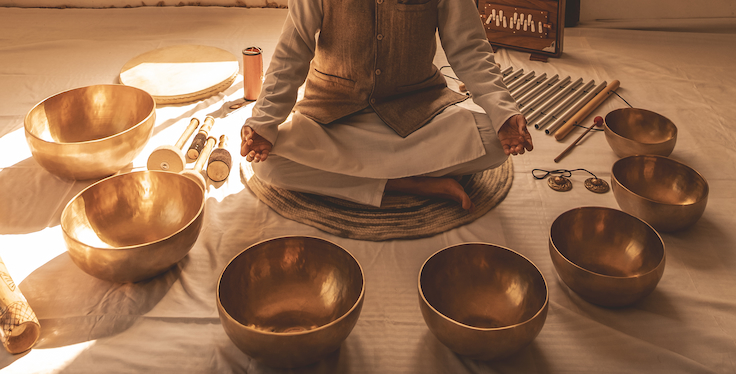Sound Healing Course in Rishikesh —
Sound healing and meditation with singing bowls is an increasingly recognized practice, gaining significant acceptance in Europe, the USA, Canada, and other regions as a leading form of sound therapy. Utilizing the powerful vibrations of specially designed healing bowls, this methodology facilitates entry into deeply altered states of consciousness, specifically the alpha-theta brainwave state, where healing processes are enhanced. Rooted in over 5,000 years of Indian medicine, sound medicine draws from both ancient wisdom and contemporary scientific insights. According to these traditions and modern physics, the universe and humanity are fundamentally composed of sound. When individuals are exposed to appropriate sound frequencies, their cells can vibrate and reorganize, aligning with an inherent blueprint for health. This underscores the profound relationship between sound and well-being, highlighting the potential for sound therapy as a transformative healing modality
History:
Music and sound-making instruments have been integral to human culture throughout history, serving essential roles in healing and consciousness transformation. Among these, singing bowls stand out as one of the most ancient and effective tools developed by humanity. Originating from India, Tibet, and the Himalayan region, singing bowls—especially those crafted from distinctive golden yellow metals—offer unique sound healing and musical properties. While they may not initially appear to be traditional musical or healing instruments, their striking reveals warm, deep vibrations that evolve into rich, harmonious sounds when played with various mallets. According to Tibetan oral traditions, the existence of Singing Bowls dates back to 560-480 B.C.; the tradition was brought back from India to Tibet, along with the teaching of Buddha by some great “ Tantric” masters in the Tibetan region. In 1951 China invaded Tibet. Then the Chinese began to destroy most of the monasteries & temples. Many monks fled the country. Living outside their country and in poverty created pressure to sell their belongings, which contributed to the gradual appearance of the singing bowls on the western market in the 1960’s & 1970’s. The understanding that these metal bowls can produce beautiful sounds and serve as tools for meditation and healing is a relatively recent development in the modern world. Historically, their use was not widely recognized, even in Tibet, where they were often kept confidential by monks and lamas. Singing bowls have long been integral to the Great Vedic Civilization, Buddhist meditation practices, and the spiritual traditions of the Himalayan culture. Initially reserved for select monks in secluded monasteries, these bowls carry a sense of mystique and embody the essence of divine enlightenment through their sacred vibrations. Although the exact origins of singing bowls may be unclear, their powerful healing energies are widely recognized. As instruments that foster balance and harmony, singing bowls have tremendous potential to enhance our awareness, facilitate transformation, and promote healing. When played together, their intertwining tones produce unexpectedly rich and resonant sounds that resonate deeply within the soul, encouraging profound transformative experiences
Genral Information:
In the modern world, singing bowls are becoming increasingly popular for their healing properties and transformative energies in the fields of wellness and spirituality. Singing bowls are beautifully crafted instruments shaped like bowls, and they come in a variety of sizes and designs. They have a long history, having been made for centuries. These bowls are created using a delicate hand-hammering technique and are primarily composed of sacred metals like copper and tin. To enhance their vibrational qualities, small amounts of other metals such as mercury, iron, nickel, cadmium, silver, and zinc are also included. Each of these metals adds its unique frequency, enriching the soothing sounds that emanate from the bowls and creating a truly special experience. The harmonic sounds produced by singing bowls significantly enhance meditation, effectively reducing stress, promoting deep relaxation, balancing chakras, and supporting holistic healing. They also hold a respected place in world music. When played with a wooden mallet, singing bowls create rich harmonic overtones that directly impact the chakras, awakening a profound energy. Resonating with the sacred sound of "AUM," their vibrations can transform our perception of space, mind, and time. Ancient Ayurvedic Sage Charak observed that the synergy of vibration and massage could effectively treat various ailments, coining the term “samvahan,” meaning “re-awakening of tissue.” This perfectly captures how the bowls rejuvenate stagnant areas and activate the body’s natural healing abilities. The human body functions like an orchestra, with each organ, tissue, and cell representing a unique instrument. Just as an orchestra requires tuning, the singing bowl therapist acts as a conductor, ensuring harmonious resonance. Our nervous system is highly sensitive to sound. While discordant noises can be harmful, the soothing sounds of singing bowls promote healing. The combination of sound heard and vibrations felt creates a holistic effect on body, mind, and spirit. As the vibrations resonate with our cells, sound waves travel through the body—composed of over 70% water—creating a gentle cleansing effect. This process harmonizes and energizes over 100 trillion cells, similar to how a supersonic cleaner loosens dirt. The vibrations from singing bowls release energy blockages and provide calming effects that reach deep into the bones. As a powerful complementary therapy, many clients experience relief from pain and tension after just one session, while others may notice significant changes after a few treatments.





